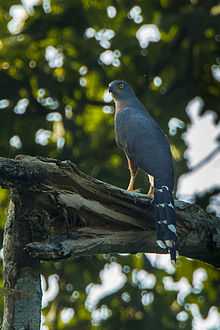Long-tailed hawk
| Long-tailed hawk | |
|---|---|
 | |
| Conservation status | |
| Scientific classification | |
| Kingdom: | Animalia |
| Phylum: | Chordata |
| Class: | Aves |
| Order: | Accipitriformes |
| Family: | Accipitridae |
| Genus: | Urotriorchis Sharpe, 1874 |
| Species: | U. macrourus |
| Binomial name | |
| Urotriorchis macrourus (Hartlaub, 1855) | |
The long-tailed hawk (Urotriorchis macrourus) is a bird of prey in the family Accipitridae, which also includes many other diurnal raptors such as kites, eagles and harriers. It is the only member of the genus Urotriorchis.[2]
This hawk inhabits the tropical rainforests of western and central Africa. It has a wingspan of 81–90 centimetres (32–35 in) and a total length of 56–65 centimetres (22–26 in), including the tail of 30–37 centimetres (12–15 in).[2] Females are about 15% larger than males.[2] Since the tail comprises about 56% of this raptor's total length, this species ties with the cinereous harrier as the raptor with the longest tail relative to its body size.[2]
The long-tailed hawk primarily eats squirrels and small birds; it can also hunt chickens in the villages close to the forest. It kills prey by breaking the neck.
The mating season occurs in July and August, when the pair build a nest on a high tree. Little is known regarding nesting and breeding the young.
Etymology
"Uro-" is from the Greek "tail",[3] and "triorchis" meant a kind of hawk thought to have three testicles—for further details see Eutriorchis. "Macro-" is from the Greek for "long",[3] so macrourus means "long-tailed", as in the English name.
References
- ↑ BirdLife International (2012). "Urotriorchis macrourus". IUCN Red List of Threatened Species. Version 2013.2. International Union for Conservation of Nature. Retrieved 26 November 2013.
- ↑ 2.0 2.1 2.2 2.3 Ferguson-Lees & Christie (2001). Raptors of the World. Christopher Helm, London. ISBN 0-7136-8026-1
- ↑ 3.0 3.1 Williams, Tim (2005), A Dictionary of the Roots and Combining Forms of Scientific Words, Lulu.com, ISBN 978-1-4116-5793-9
